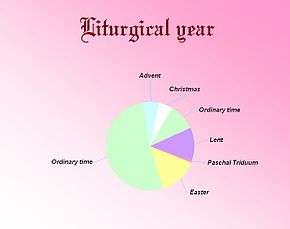Laetare Sunday



Laetare Sunday (/liːˈtɛərɪ/ or /laɪˈtɑːrɪ/),[1] so called from the incipit of the Introit at Mass, "Laetare Jerusalem" ("Rejoice, O Jerusalem"), from Isaiah 66:10, is a name often used to denote the fourth Sunday of the season of Lent in the Western Christian liturgical calendar.
History
The term "Laetare Sunday" is used by most western rite liturgical traditions (including the Roman Catholic and Anglican churches) and by some Protestant denominations with western-rite origins. The word translates from the Latin laetare, the singular imperative of laetari: "to rejoice." Laetare opens the traditional mass introit of the day.
The full Introit reads:
"Laetare Jerusalem: et conventum facite omnes qui diligitis eam: gaudete cum laetitia, qui in tristitia fuistis: ut exsultetis, et satiemini ab uberibus consolationis vestrae. Psalm: Laetatus sum in his quae dicta sunt mihi: in domum Domini ibimus."
"Rejoice, O Jerusalem: and come together all you that love her: rejoice with joy, you that have been in sorrow: that you may exult and be filled from the breasts of your consolation. Psalm: I rejoiced when they said to me: 'we shall go into God's House!'"
Alternative names
This Sunday is currently also known as Mothering Sunday, Refreshment Sunday, mid-Lent Sunday (in French mi-carême) and Rose Sunday (either because the golden rose (sent by Popes to Catholic sovereigns) used to be blessed at this time, or because the use of rose-colored (rather than violet) vestments was permitted on this day).
Historically it was also known as "the Sunday of the Five Loaves," from the traditional Gospel reading for the day, the story of the miracle of the loaves and fishes. The story, before the adoption of the modern "common" lectionaries, was the Gospel reading for this Sunday in the Lutheran, Anglican, Roman Catholic and Old Catholic churches.
The station at Rome was on this day made at the church of S. Croce in Gerusalemme, one of the seven chief basilicas; the Golden Rose, sent by Popes to Catholic sovereigns, used to be blessed at this time and for this reason the day was sometimes called "Dominica de Rosa".
Laetare traditions
In the Roman Catholic, Anglican, Lutheran, Old Catholic and some Protestant traditions, flowers may appear on the high altar and the organ may be played as a solo instrument. Priests are given the option to wear rose-colored vestments at Mass held on this day in place of the violet vestments normally worn during Lent.[2] The term "rose" is used to describe this lighter shade of the color violet in the Roman Catholic Church.[3] In the western liturgical system, purple is the colour of Lenten penance, while white is the colour of feast days. Rose is the color of Laetare as the color obtained naturally by mixing purple and white.
It is a day of relaxation from normal Lenten rigours; a day of hope with Easter at last within sight. Traditionally, weddings (otherwise banned during Lent) could be performed on this day,[4] and servants were released from service for the day to visit their mothers (hence 'Mothering Sunday').
Date of Laetare
Laetare Sunday can fall on any date between March 1 and April 4. The following are Laetare Sunday dates:
| Year | Date |
|---|---|
| 2013 | March 10 |
| 2014 | March 30 |
| 2015 | March 15 |
| 2016 | March 6 |
| 2017 | March 26 |
| 2018 | March 11 |
| 2019 | March 31 |
See also
References
- ↑ "Laetare". Oxford English Dictionary (3rd ed.). Oxford University Press. September 2005. (Subscription or UK public library membership required.)
- ↑ The traditional use of rose-pink vestments on this day by Anglican clergy is suggested in the liturgical colour sequence notes of Common Worship of which an on-line version may be found here (see near bottom of page).
- ↑ "Homiletic Directory". Congregation for Divine Worship and the Discipline of the Sacraments. 2015. Third Sunday of Advent, Fourth Sunday of Lent.
- ↑ See for example, Laetare Sunday extract
- Catholic Encyclopedia: "Laetare Sunday"
